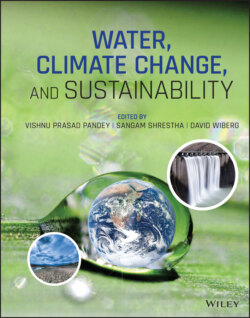Читать книгу Water, Climate Change, and Sustainability - Группа авторов - Страница 26
2.3. INTEGRATED APPROACH FOR WATER RELATED TARGETS OF SDGS
ОглавлениеThe concept of an integrated approach to water resource management has been around for at least 60 years (Biswas 2008). It has been firmly on the international policy agenda since the historic Mar del Plata UN Wáter Conference in 1977 and subsequently under the broader call for sustainable development in the First Rio Summit in 1992 (Figure 2.1). Since the adoption of 2030 Agenda and SDGs, the relevancy of integrated approach of water resources management has re‐surfaced strongly. An integrated approach to implementing SDGs will allow more cohesive monitoring (including coordination between existing frameworks), maximize available resources for implementation, and ensure that certain goals are not achieved at the detriment of others (Schuster‐Wallace and Sandford 2015).
IWRM is a conceptual framework meant to describe the complexity of water decisions, including planning, organising, and operating water systems, and to balance views and interests of relevant stakeholders (Grigg 2008). IWRM reflects a holistic attempt to co‐manage sub‐sectors (water supply, irrigation, storm water and flood management, sanitation and water quality) and their interaction with other cross‐cutting sectors (industry, energy, agriculture, ecosystem, and bio‐diversity, etc.). Despite its merits, the concept of IWRM, as well as the vision of sustainable development, confront similar challenges in that they lack clear operational roadmaps driving their implementation (Shivakoti and Bengtsson 2015). Implementation of IWRM is difficult because of institutional barriers and confusion over the precise meaning of the concept (Grigg 2008). So far, IWRM has been successful in establishing its “brand” but there is a tendency to regard awareness‐raising on the concept as an end in itself rather than as a means to achieving integrated management of water resources (Giordano and Shah 2014). A recent assessment by found that the vast majority, 80%, of countries have laid the foundations for IWRM while their operationalization are yet to accelerate (UN Environment 2018; Bertule et al. 2018). It is unlikely that 60% of countries will meet the global target on IWRM (6.5) unless progress significantly accelerates. There have been many efforts to promote IWRM at international level, such as by Global Water Partnership (GWP), International Network of Basin Organizations (INBO), UN‐Water, or Network of Asian River Basin Organizations (NARBO). Or regional level initiative such as ASEAN Working Group on IWRM which, among others, intends to promote networking and collaboration for the implementation of IWRM1. Development banks like Asian Development Bank and African Development Banks have made IWRM the core of their water related activities (Giordano and Shah 2014). Incorporation of IWRM in the national water laws and policies by many countries may be seen as an outcome of international efforts to promote IWRM (UN Environment 2018).
Figure 2.1 Key global agreements on IWRM.
Source: Bertule, M., Glennie, P., Bjørnsen, P.K. et al. (2018).
The establishment of river basin organizations (RBOs) at local, national, as well as transboundary (such as the Mekong River Commission) can be viewed as a common response to establish an institutional mechanism to implement policies and laws related to IWRM. The processes of implementing IWRM are diverse and looking at the existing policy, legal and institutional mechanisms, it is difficult to understand how the process of IWRM implementation really works at different levels and how various outcomes can be related to IWRM processes (Giordano and Shah 2014). For instance, a variety of council, public, and corporate models, and examples of RBOs are now helping governments and stakeholders across Asia to implement IWRM that is tailored to their local conditions (Isnugroho and Nielsen 2014).
Despite the mixed experience in implementing IWRM, the need for integrated approaches to water resource management has become more pressing than ever since the adoption of SDGs, including SDG6. The need for integrated approaches is also reflected in discussions around a number of other policy concepts such as climate adaptation (Cap‐Net 2009, Mysiak, et al. 2010), the Fifth Assessment Report of the IPCC (IPCC 2014), Green Economy (GE) agenda (UNEP 2011). The concepts of “virtual water” and “water footprints” highlight the intense water use in global supply‐chains and the role played by a growing trade in increasing water demand. The nexus approach is yet another strand of thinking that points towards the need for enhanced coordination among key sectors, in particular water, food, energy, land use, and climate (Hoff 2011, WEF 2011). The nexus approach, when viewed from the “water angle”, is a way to put the concept of integrated approaches into practice by prioritising sectors that “will affect” and “will be affected by” water issues more than others. The SDGs provide an opportunity to try to operationalize integrated approaches in the real world.
